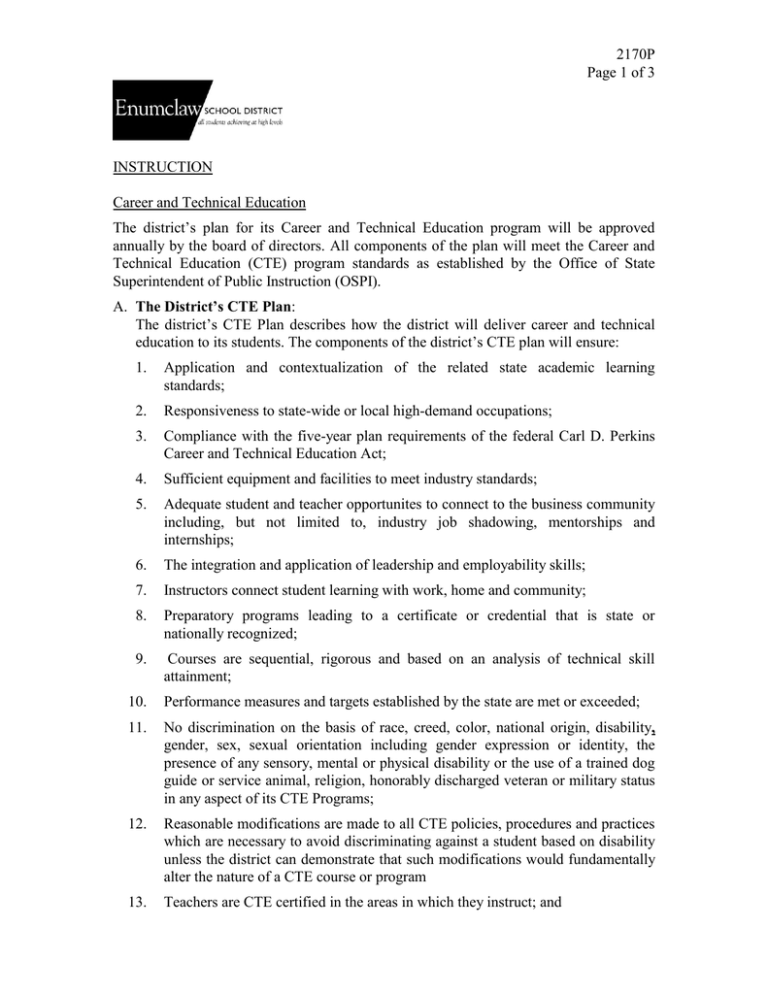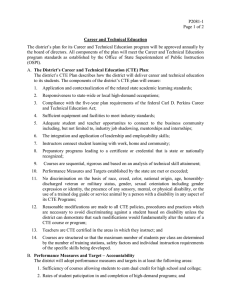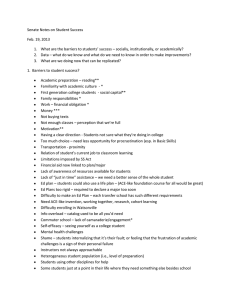2170P INSTRUCTION Career and Technical Education
advertisement

2170P Page 1 of 3 INSTRUCTION Career and Technical Education The district’s plan for its Career and Technical Education program will be approved annually by the board of directors. All components of the plan will meet the Career and Technical Education (CTE) program standards as established by the Office of State Superintendent of Public Instruction (OSPI). A. The District’s CTE Plan: The district’s CTE Plan describes how the district will deliver career and technical education to its students. The components of the district’s CTE plan will ensure: 1. Application and contextualization of the related state academic learning standards; 2. Responsiveness to state-wide or local high-demand occupations; 3. Compliance with the five-year plan requirements of the federal Carl D. Perkins Career and Technical Education Act; 4. Sufficient equipment and facilities to meet industry standards; 5. Adequate student and teacher opportunites to connect to the business community including, but not limited to, industry job shadowing, mentorships and internships; 6. The integration and application of leadership and employability skills; 7. Instructors connect student learning with work, home and community; 8. Preparatory programs leading to a certificate or credential that is state or nationally recognized; 9. Courses are sequential, rigorous and based on an analysis of technical skill attainment; 10. Performance measures and targets established by the state are met or exceeded; 11. No discrimination on the basis of race, creed, color, national origin, disability, gender, sex, sexual orientation including gender expression or identity, the presence of any sensory, mental or physical disability or the use of a trained dog guide or service animal, religion, honorably discharged veteran or military status in any aspect of its CTE Programs; 12. Reasonable modifications are made to all CTE policies, procedures and practices which are necessary to avoid discriminating against a student based on disability unless the district can demonstrate that such modifications would fundamentally alter the nature of a CTE course or program 13. Teachers are CTE certified in the areas in which they instruct; and 2170P Page 2 of 3 14. Courses are structured so that the maximum number of students per class are determined by the number of training stations, safety factors and individual instruction requirements of the specific skills being developed. B. Performance Measures and Target – Accountability The district will adopt performance measures and targets in at least the following areas: 1. Sufficency of courses allowing students to earn dual credit for high school and college; 2. Rates of student paticipation in, and completion of, high-demand programs; and 3. Performance measures and targets established by the Workforce Training and Education Coordinating Board, including but not limited to student academic and technical skill attainment, graduation rates, post graduation employment or enrollment in post-secondary education and other measures and targets as required by the federal Carl D. Perkins Act. C. Course Equivalencies Each of the district’s high schools will adopt core academic course equivalencies for high school CTE courses, provided that the CTE course has been reviewed and approved for equivalency credit by a district team appointed by the superintendent or a designee, in accordance with district policy 2413, Equivalency Credit for Career and Technical Educational Courses. D. Career and Technical Education Programs of Study A program of study is a sequence of courses that identifies the secondary and postsecondary content that students need to take to ensure that they will have the knowledge and skills needed for a seamless transition to post-secondary options. The district’s CTE program(s) of study will: 1. Incorporate secondary CTE academic and elective courses and local graduation requirements as well as post-secondary education elements; 2. Include coherent and rigorous academic content aligned with state learning standards and relevant career and technical content in a coordinated, nonduplicative progression of courses that are aligned with post-secondary education in a related field; 3. Include courses aligned with appropriate state academic, industry, leadership and employability standards; and 4. Lead to industry-recognized credentials, an academic certificate or degree, apprenticeship, employment or certificate at the post-secondary level. E. Career Guidance and Counseling Career guidance and counseling programs shall include the exploration of options and opportunities for CTE at the secondary and post-secondary level and exploration of career opportunities in emerging and high-demand programs. (See WSSDA model Policy 2140, Guidance and Counseling) 2170P Page 3 of 3 F. Advisory Committees 1. Advisory committees will participate in the determination of program goals, and review and evaluate program curriula, equipment and effectiveness. 2. Advisory committee participants will include representatives of business and labor who reflect the local industry and the community. Members will actively consult with other representatives of business, industry, labor and agriculture. 3. The superintendent, in consultation with the director of CTE programs, will select members of the advisory committees. Advisory committee members will be approved by the board. Updated: 09.11

